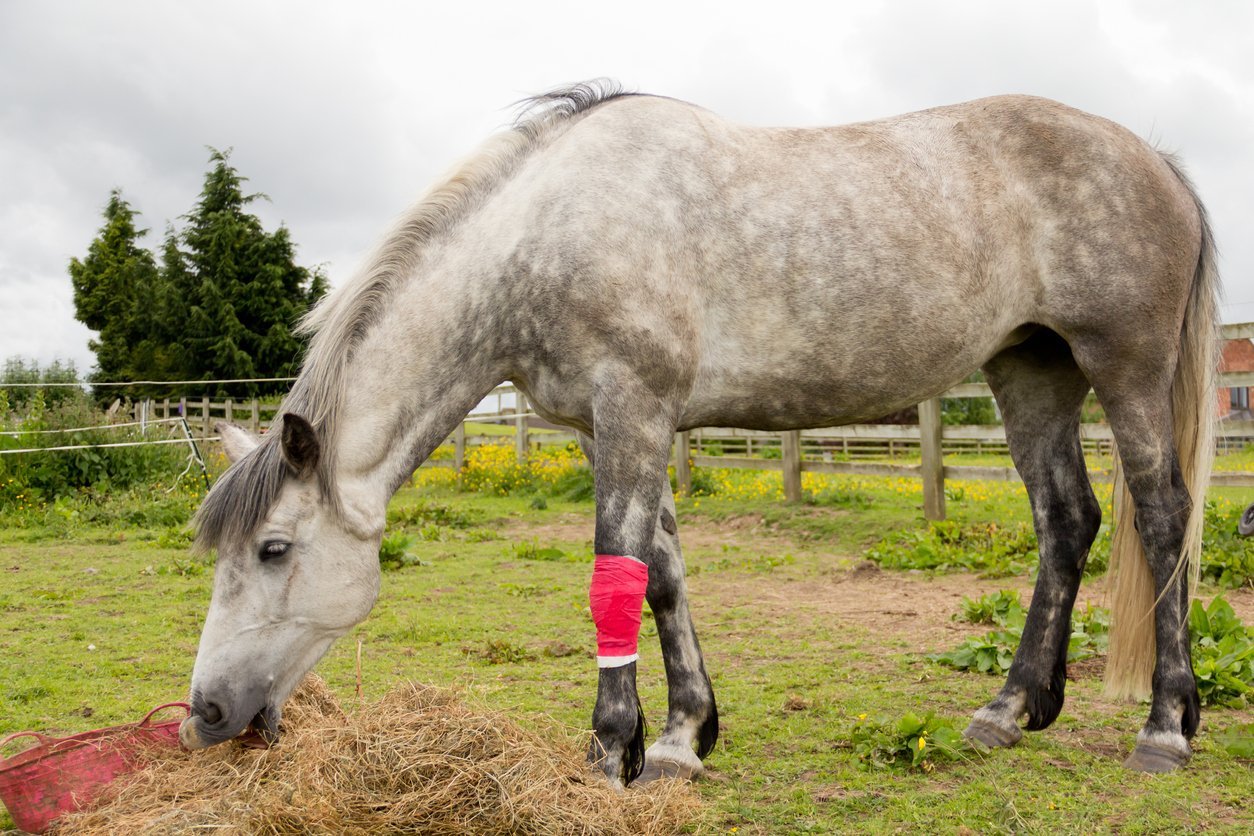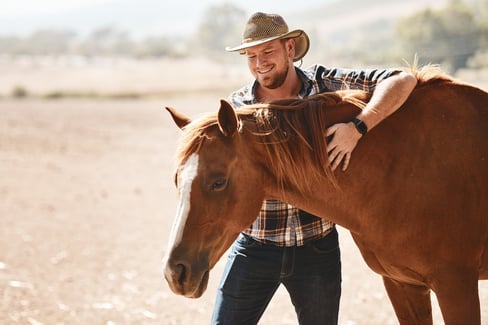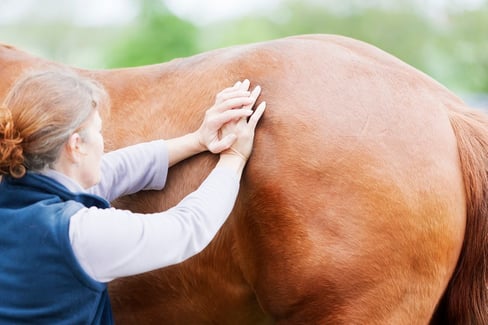Table of Contents
Horse injuries can “stirrup” a lot of stress.
And suspensory ligament horse injuries are no joke.
Not only are ligament strains and tears painful for your equine pal. They can also take months to heal.
So we get that you want to learn everything you can about how to prevent this injury from happening in the first place.
But wait. You’re here because your horse is already injured?
You’ve come to the right place for that, too. In this post, we’ll cover both general prevention and treatment measures for horse ligament injuries.
So you can rest easy knowing you’re doing all you can to set your horse up for ligament health success.
Let’s get started!
What is the Suspensory Ligament in Your Horse?
So before we get too ahead of ourselves here, you probably need a brief refresher on what a ligament is, right?
Fortunately, it’s pretty straightforward: ligaments are connective tissues that attach bone to bone. They help your horse move.
And the suspensory ligament supports your horse’s fetlock. If you don’t know where that is, just look for the small tuft of hair on your horse’s ankle, above his hoof.
The suspensory ligament begins below your horse’s knee at the cannon bone. It then runs down through the fetlock, where it branches and attaches to the sesamoid bones. If you’re a visual learner, check out the diagram below to learn more about horse suspensory ligament anatomy:
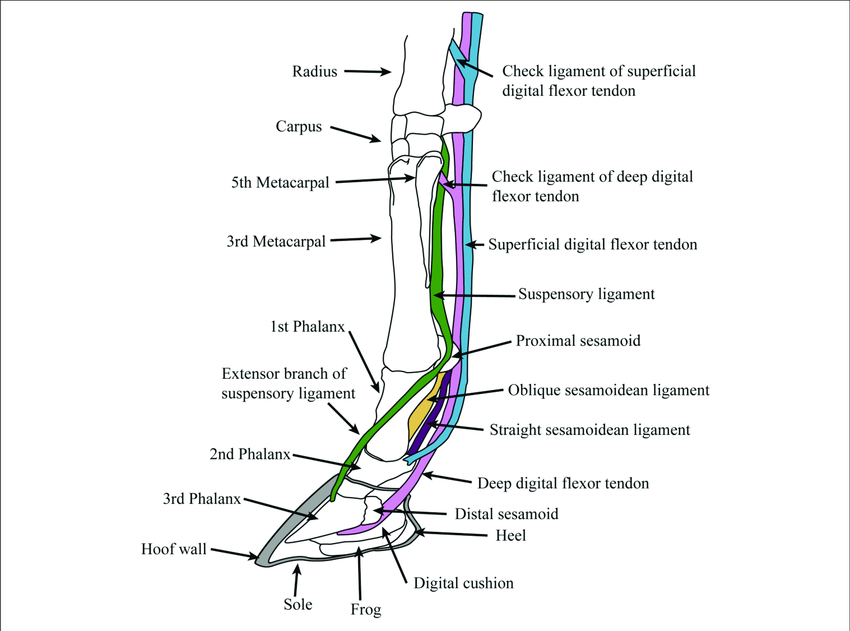
This ligament in particular helps protect your horse’s fetlock from dropping too low (known as hyperextension) during exercise.
The long and short of it is that the suspensory ligament supports your horse’s weight and absorbs shock as he jumps or runs.
The bummer?
Suspensory ligament injuries account for around 46% of limb injuries in horses.
Injuries to this ligament occur in one of two ways:
- Your horse places too much weight or forces on the suspensory ligament (which leads to sudden injury).
- Your horse’s body is overworked, which can lead to an injury to the suspensory ligament that gradually gets worse.
So how do you know if your horse is injured? Read on below.
Horse Suspensory Ligament Injury Symptoms

You’re out training with your horse and just came down from an epic jump.
But after landing, your horse has suddenly gone lame. We know how much that sucks, especially because you’re probably already doing all you can to maintain your horse’s health.
Unfortunately, this lameness could be caused by a suspensory ligament injury. Some of the symptoms of a suspensory ligament horse injury are below:
- Heat
- Swelling pain
- Lameness (can range from mild to severe)
- Reluctance to move forward
The symptoms of this injury vary depending on where a tear is located.
This is because the origin of the suspensory ligament is surrounded by a lot of other anatomical structures. This can make it difficult to notice symptoms like swelling in this area.
If the injury occurs lower down on your horse’s suspensory ligament, however, swelling will be easier to notice.
If you notice any of the symptoms above, you should pay a visit to the equine vet. Your vet will examine your horse to see whether he has injured his suspensory ligament.
The exam may include feeling around the horse’s fetlock and/or lower leg, as well as watching your horse walk and trot.
Recovery from Suspensory Ligament Horse Injuries
You want to make sure you’re doing everything you can to support your sport horse’s injury recovery.
In this case, that’s going to mean two things: a lot of equine vet appointments and a lot of patience.
Your vet will need to assess your horse’s progress towards recovery through multiple follow-up appointments. These exams will determine what stage of recovery your horse is in and whether he’s ready to move on to the next phase of recovery.
The length of recovery will vary depending on the extent of the injury:
- A minor strain may heal in as little time as six to eight weeks.
- A tear may take upwards of eight to twelve months to fully heal.
This is where patience comes in, my friend. While your horse is in recovery, don’t try to ride or train him (we hope this is obvious!).
Additionally, you’ll want to minimize the amount of weight your horse places on his strained or torn suspensory ligament. Over time, he’ll move through the different phases of rehabilitation, where your horse will gradually begin to place more weight on his limbs.
We’ll discuss this next.
Rehabilitation for Horse Suspensory Ligament Injuries
Good things take time. Don’t rush your horse’s suspensory ligament injury rehabilitation!
There are three important parts of the rehabilitation process:
- Icing and Anti-Inflammatories
- Stall Rest
- Physical Therapy/Gradual Reintroduction to Exercise
The first two parts happen concurrently for the first couple of weeks. Your vet may ask you to ice the injury, as well as prescribe anti-inflammatory medicines to help reduce swelling and pain.
During this time, your horse should be on strict stall rest to help minimize the possibility of aggravating his injury. This may be necessary for weeks to months, depending on the extent of the injury.
Let’s repeat that: the absolute best thing you can do for your sport horse’s performance during this time is next to nothing at all.
Your vet will determine when your horse is ready to move from stall rest to the third phase: physical therapy.
To begin, your vet will likely start you off by hand-walking your horse. A walk of about 10 minutes per day will help your horse get gradually reacquainted with movement and exercise.
After two to three months, your vet may give the okay to begin working on a trot again. During this time, you’ll want to ensure your horse has the correct foot balance. This allows your horse to step down correctly as they heal, while not overcompensating (and potentially injuring) his other limbs.
Treatment for Horse Suspensory Ligament Injuries
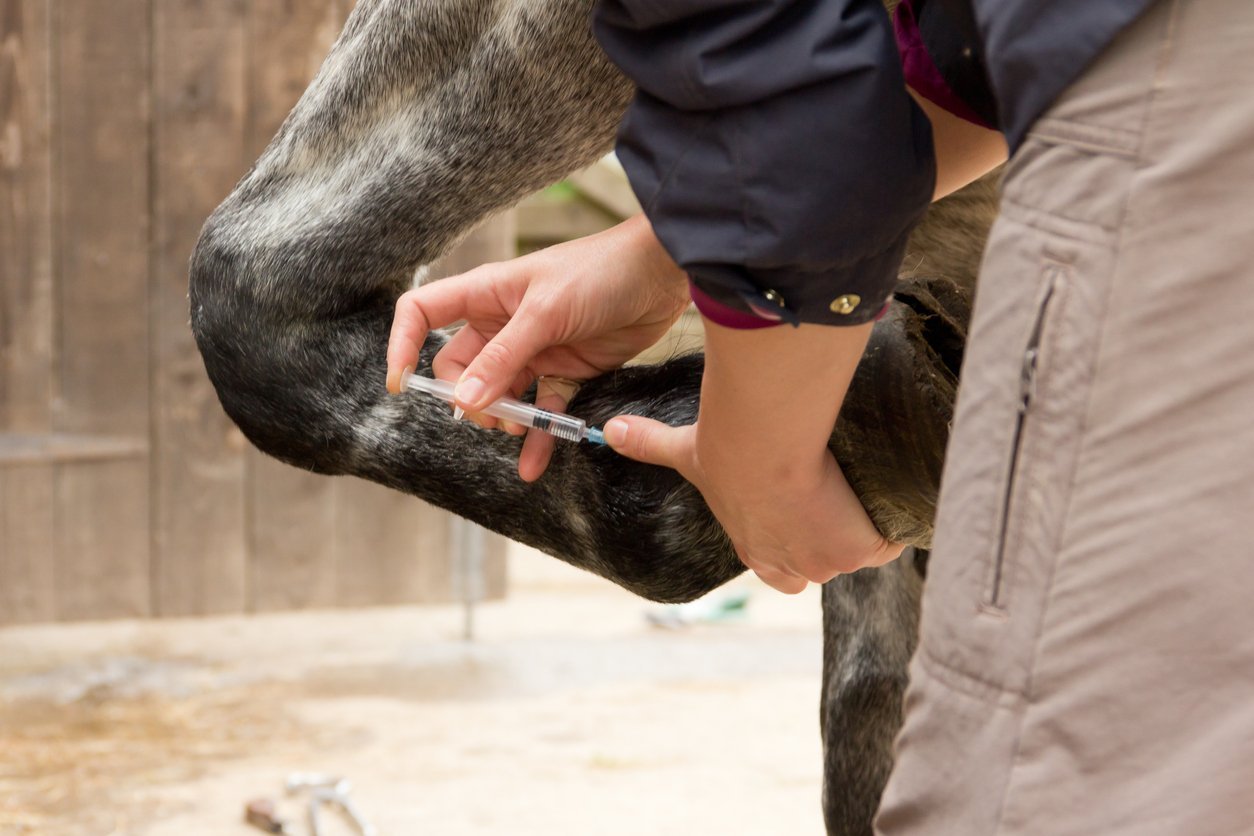
There are a variety of treatment options available for suspensory ligament horse injuries. We’ll go into detail about each specific type below.
But just to whet your appetite, we’ve listed some treatment options here:
- Surgery
- Anti-Inflammatory Drugs
- Icing Injury
- Rest, Rest, and More Rest
- Physical Therapy
Fortunately, the most invasive treatment measure (surgery) is also the rarest.
When your horse is first injured, you will work closely with your equine vet to determine the right course of treatment for your horse’s suspensory ligament injury. Every horse’s recovery plan will be different depending on the location and extent of his injury.
And in case you haven’t heard it quite enough already: the path to recovery for a suspensory ligament injury may be slow.
Don’t try to rush your horse’s recovery!
General Preventative Measures
With recovery from a suspensory ligament horse injury taking months, it’s no wonder you’re looking for some preventative measures. We’ve got you covered. Below are some tips to help maintain your horse’s suspensory ligament health.
1. Promote Muscle Health
The health of your horse’s muscles has impacts beyond just strength: muscles support your horse’s tendons and ligaments. Tendon and ligament injuries often occur when a horse’s muscles are over-exhausted or underused.
The stronger your horse’s muscles, the better able he is to avoid an injury to his suspensory ligament.
So, naturally, it’s vital that you maintain the muscle health of your horse.
How, you ask?
Exercise is a great way to promote muscle, tendon, and ligament health. In fact, the more regular exercise your horse receives at a young age, the stronger his tendons and ligaments will be.
Additionally, exercise helps your horse avoid muscle atrophy. Muscle atrophy occurs in all horses but is especially common as horses get older.
And when it comes to nutrients, providing your horse with vitamins and mineral supplements like selenium and Vitamin E promotes muscle health and helps your horse avoid muscle aches.
Just be careful when it comes to selenium, as too much of this mineral can be toxic for your horse.
2. Work on Balance
What do you call a well-balanced horse?
Stable.
Sorry, we couldn’t resist.
Working on your horse’s balance (and your balance!) is a great way to help prevent suspensory ligament injuries.
Improper balance may be more likely to result in suspensory ligament strains, especially in younger horses.
When you are properly balanced on your horse, you make it so that your horse doesn’t have to adjust his movement to compensate for your irregularly distributed weight.
This is important because over time, compensating for an unbalanced rider can lead to strains and injuries (like a suspensory ligament injury!) in your horse.
In addition to working on your balance, you can help your horse maintain proper hoof balance. Doing so helps avoid undue stress on your horse’s suspensory ligament.
A great way to help with foot balance is by training on level ground. This reduces the likelihood that your horse’s hooves will dip at unnatural angles or in unhealthy ways.
3. Provide Horse Supplements
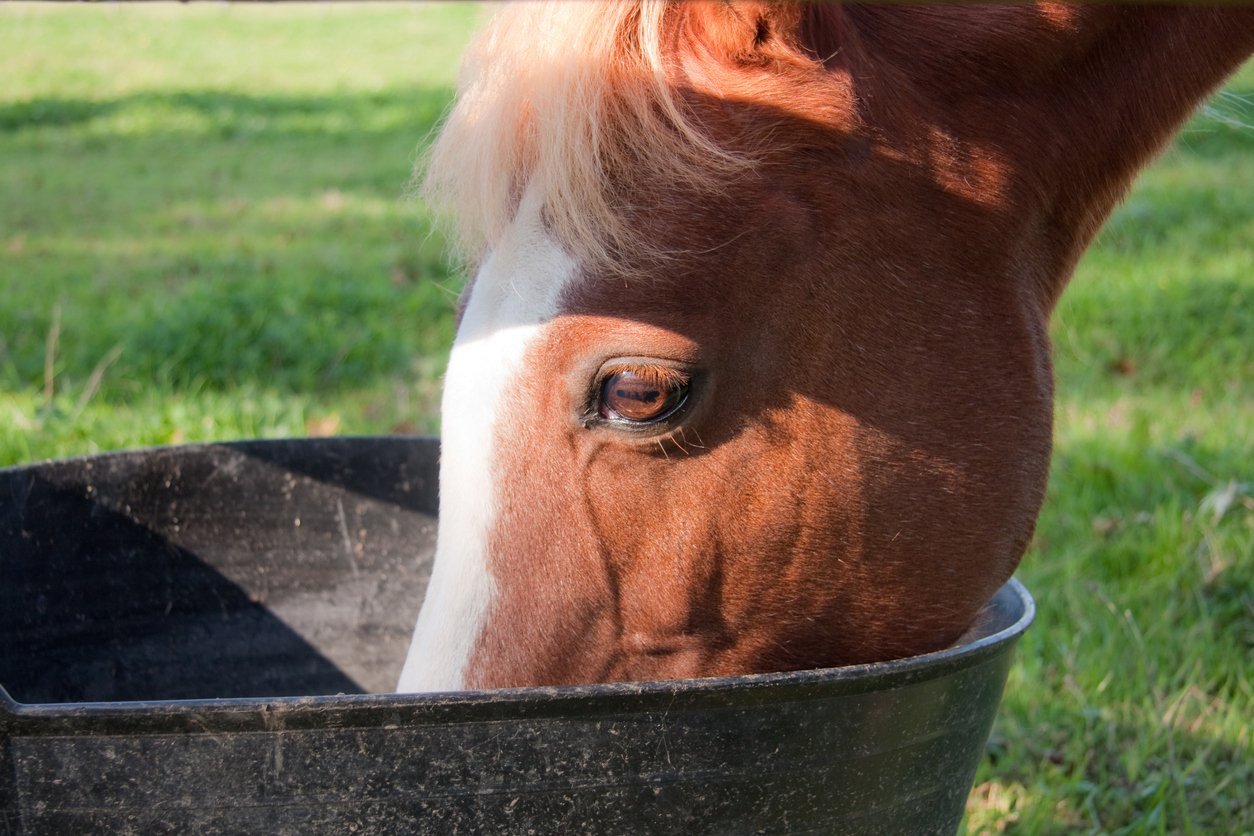
So you’ve done what you can to promote muscle health and you’re actively working on proper balance.
What next?
Horse supplements.
Active ingredients, such as glucosamine, in some horse supplements, are great for promoting ligament health. This is because glucosamine is a building block for ligaments.
In particular, there are two types of glucosamine to look out for:
- Glucosamine hydrochloride: highly bioavailable, which means your horse can actually use this type of glucosamine.
- Glucosamine sulfate: contributes to collagen production, which is an important component of ligaments.
The table below outlines some other active ingredients that can help maintain your horse’s health:
| Ingredient | Benefit |
| Glucosamine |
|
| Chondroitin |
|
| MSM |
|
| Hyaluronic Acid |
|
But with so many supplements on the market, it can be difficult to choose the right one for your horse. The key is to try and find a supplement that consists primarily of active ingredients (no fillers!), which helps ensure your horse is getting the most bang for his buck.
We’re especially partial to TRI-ACTA for Equine and its maximum strength counterpart, TRI-ACTA H.A. for Equine. Each of these supplements consists of 100% active ingredients, as well as ingredients like glucosamine to help support suspensory ligament health.
4. Maintain Proper Shoeing
You wear shoes for a reason.
So does your horse.
Your horse’s hooves absorb a lot of shocks as he trains. Each time your horse takes a step, energy moves up the horse’s foot into the suspensory ligament.
Proper shoeing can help reduce the likelihood of a suspensory ligament horse injury. This is because a proper horseshoe helps your horse maintain balance. And we’ve already established how important balance is for promoting ligament stability and health!
Fortunately, maintaining proper shoeing is simple. A visit to the farrier every four to six weeks for reshoeing and a hoof trim goes a long way in preventing injuries.
And if your horse is injured already, a therapeutic shoe may help him heal faster. This is because shoes can change the distribution of stress and weight on your horse’s hooves, helping reduce the amount of weight placed on the injured area.
5. Avoid Overworking Horse
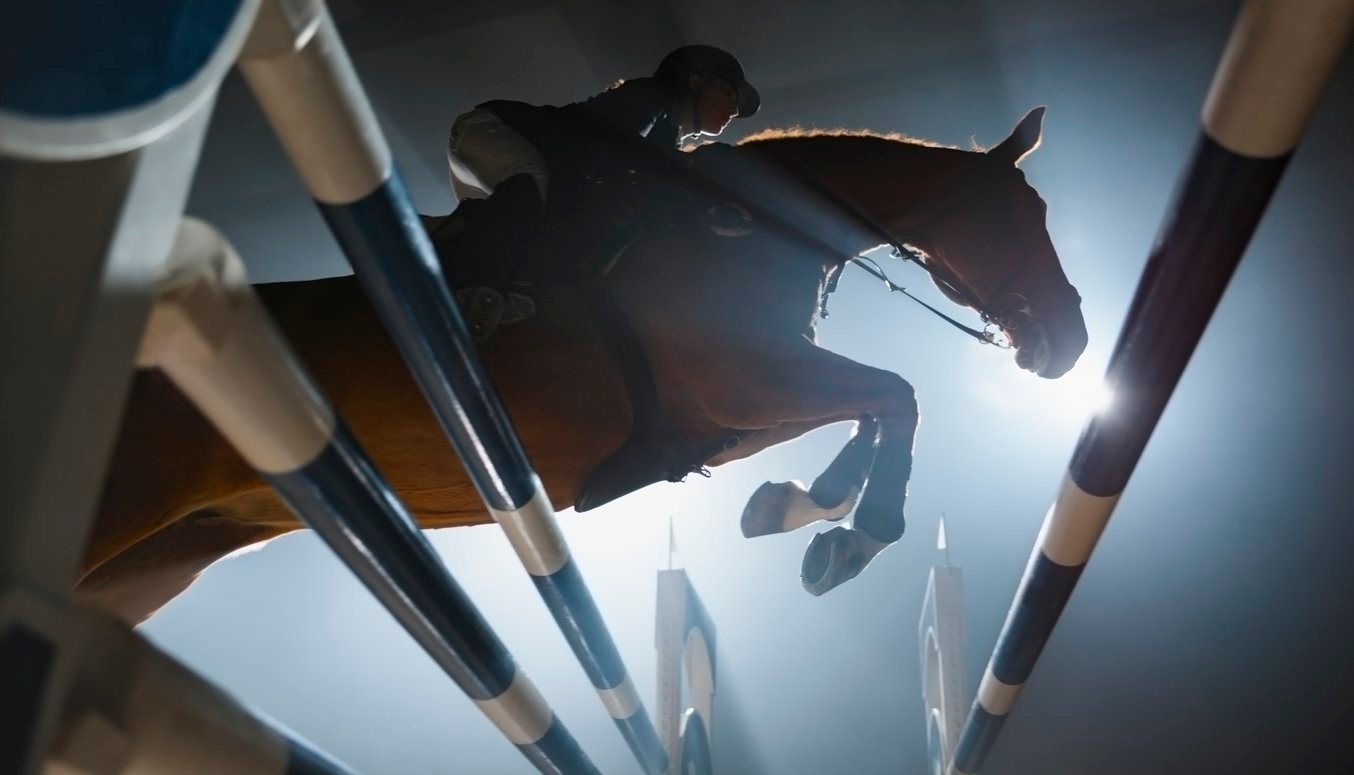
The last preventative tip on our list is also one of the things you have the most control over: don’t overwork your horse!
Pushing your horse too hard means he won’t have enough energy to maintain proper form or gait when training. Injuries are especially common at the end of a long day when a horse has exhausted all of his energy getting to the finish line.
And when it comes to a suspensory ligament injury, all it takes is landing wrong on his leg once to leave your horse on stall rest for months.
Before getting too deep into a training session, make sure you give your horse proper time to warm up. Starting out too quick, too early can also place stress on your horse’s muscles, tendons, and ligaments.
And if you have a particularly intense workout session, make sure to go easy the next day. Just like a human, your horse’s body needs time to recover!
General Treatment Measures
Preventative measures are great and all, but you also want to know how to help your horse that’s already suffering from a suspensory ligament injury. Below are five general treatment measures that your vet may recommend to help your horse recover.
1. Anti-Inflammatory Drugs
The first general treatment measure is pretty self-explanatory: anti-inflammatories help reduce inflammation in your horse’s body.
And reducing inflammation helps minimize swelling, which aids your horse in recovering from suspensory ligament injuries.
Another bonus? Anti-inflammatories also minimize the pain your horse may be experiencing from his injury.
Keep in mind that you should never give your horse over-the-counter medicines made for humans. Instead, you should consult with your vet.
She can then prescribe your horse an anti-inflammatory that is safe for horses, such as Bute or Finadyne.
2. Icing Injury
In addition to giving your horse an anti-inflammatory medicine, icing his injury can also help reduce swelling.
You should aim to ice your horse’s suspensory ligament injury three to five times daily for 15 to 20 minutes at a time. Keep in mind that there is such a thing as too much ice, so be sure that your horse also gets plenty of time without ice each day.
If the thought of icing your horse makes you spook, there are a few options that may make things easier for you.
You can purchase boots that are specifically made to help with icing injuries. These boots contain ice packs, which makes icing your horse’s injury as simple as wrapping a boot around his injured limb.
Alternatively, you can cold hose your horse, which is exactly like it sounds. Simply use a garden hose to run cool water over your horse’s injury for 15 minutes several times a day.
You can try both of these methods (icing or cold hosing) to see which seems to work best for your horse.
The table below shows some of the benefits of the different icing techniques available to you.
| Icing Technique | Benefit |
| Iced Boot |
|
| Cold Hosing |
|
| Applying Ice Packs |
|
3. Rest

Rest is perhaps the most important treatment measure for a horse suffering from a suspensory ligament injury.
And when we say rest, we mean confining your horse to his stall, not letting him walk in a field. It really is best for your horse’s movement to be kept to an absolute minimum.
Since every case is different though, consult with your vet about what your horse should or should not do while recovering from a suspensory ligament injury.
The length of time your horse will need to spend resting will depend on a variety of factors, including his overall health and the extent of his injury.
The need for restricted movement can range from three months up to a year. Patience really is key here!
Your equine vet will let you know when your horse is ready to move from the resting phase to a gradual reintroduction of movement and/or physical therapy.
4. Physical Therapy
After lots and lots of rest, your horse is going to need to strengthen his suspensory ligament again.
One way of doing this is through physical therapy. There are different types of physical therapy, so you should work with your vet to identify what will work best for your horse.
Physical therapy may include some (or all) of the different activities listed below:
- Shockwave therapy
- Laser therapy
- Stretching
- Massage
- Strengthening exercises
In addition to your vet, a licensed physical therapist can help you and your horse navigate this part of his recovery.
You can also lead your horse through certain strengthening exercises. In the beginning, this will look like simply hand-walking your horse on flat terrain. As he gains strength, you can begin working on his trot and cantor, taking care not to push him too far, too fast.
5. Surgery
The bad news: your horse has a suspensory ligament injury.
The good news: it’s uncommon for horses to need surgery to recover from this condition.
Your equine vet may recommend surgery to treat a suspensory ligament horse injury if your horse is also suffering from blood clotting as a result of his injury.
Additionally, surgery may be used if the other treatment options discussed above have not helped your horse recover.
The need for surgery tends to be more common for horses that have a suspensory ligament injury in their hind limbs.
Your vet will discuss different surgical options with you if relevant. Some surgical methods may be more beneficial for your horse than others depending on the extent and location of his injury.
Q&A on Suspensory Ligament Horse’s
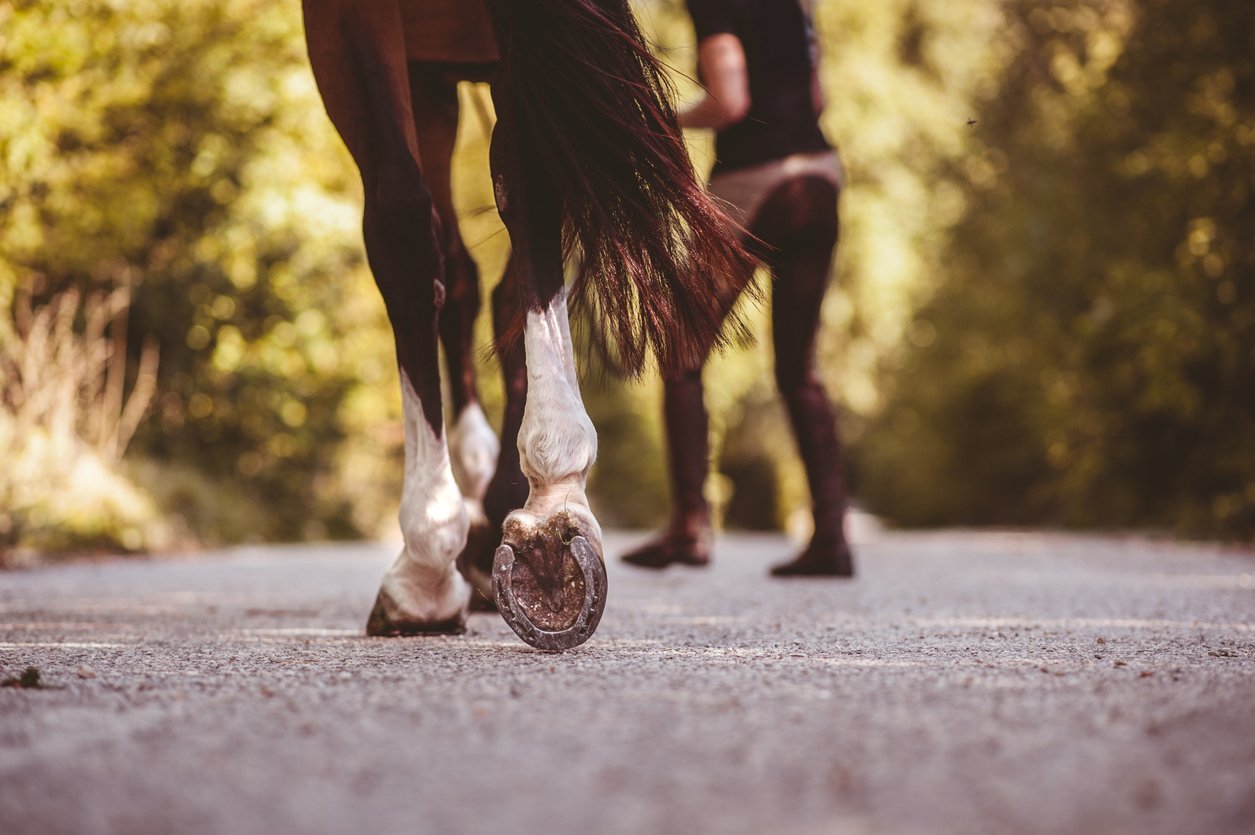
“Can a horse recover from a suspensory ligament injury?”
Of course, they can! But keep in mind that recovery from this condition is slow, so you’ll need to be patient. And in some cases, like if your horse has suffered from an especially severe injury, he may not return to the same level of performance he had pre-injury. Ensure your horse has plenty of time to rest and heal before diving into training again.
“Can you ride a horse with a degenerative suspensory ligament?”
No! One of the most important things you can do to help your horse recover from a suspensory ligament injury is allow him to rest. This means you should avoid adding any additional stress to your horse’s body, which includes not riding him.
“How long do suspensory ligament injuries take to heal?”
The length of time it will take your horse to heal largely depends on the extent of his injury. In general, you should plan for at least a couple of months of stall rest and greatly reduced activity. For especially bad suspensory ligament injuries, your horse may take closer to a year to fully heal.
Conclusion
There’s nothing fun about a suspensory ligament horse injury.
It’s going to test your patience.
But the best thing you can do for your horse is provide him with an abundance of time to rest.
And prevention, such as by feeding your horse a supplement, goes a long way in avoiding an injury in the first place.
Now that you know the basics of preventative and treatment measures, you can work closely with your vet to determine what will work best for your horse.
Looking to learn even more? Check out our blog.
Newsletter Signup
Subscribe to our newsletter to receive the latest news and exclusive offers.
.jpg?height=2000&name=Cliick_Integricare-DISPLAY-REVISEDV2%20(1).jpg)
Proactive & Therapeutic Joint Supplements
When given daily, Integricare joint supplements recover bone and joint injuries faster and help prevent mobility injuries from happening in the first place.

